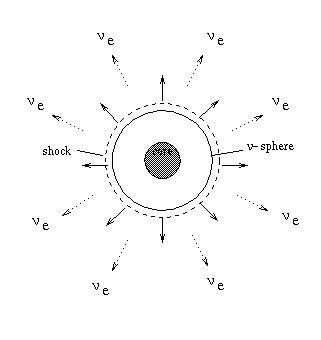

When a massive star at the end of its life collapses to a neutron star, it radiates almost all of its binding energy in the form of neutrinos, most of which have energies in the range 10-30 MeV. These neutrinos come in all flavors, and are emitted over a timescale of several tens of seconds. The neutrino luminosity of a gravitational collapse-driven supernova is typically 100 times its optical luminosity.
The neutrino signal emerges from the core of a star promptly after core collapse, whereas the photon signal may take hours or days to emerge from the stellar envelope. The neutrino signal can therefore give information about the very early stages of core collapse, which is inaccessible to other kinds of astronomy. In fact, an optical supernova display may never be seen at all for a given core collapse: some collapsing stars may never blow up into supernovae, or the star may live in an obscured region of the galaxy.
Neutrinos from gravitational collapse can be detected in various ways. For water Cerenkov detectors, such as Super-K, the most important detection reaction is the absorption of electron antineutrinos on protons:
antineu_e+p->n+positron
The positron from this reaction, which retains most of the energy of the incoming neutrino, is detected from its Cerenkov light. For a gravitational collapse at the center of the Galaxy (8.5 kpc away), Super-Kamiokande expects to see about 5000 events. A few percent of the supernova events observed will be neutrino-electron elastic scattering events (neutral current and charged current),
neu_x+e -> neu_x +e,
where neu_x is a neutrino of any flavor.
Although their cross-sections are two orders of magnitude smaller than for the inverse beta decay reaction, the elastic scattering reactions are of particular significance for water Cerenkov detectors, because unlike the products of the inverse beta decay reaction, the electrons scattered by neutrinos retain some of the direction information of the incoming neutrinos. Information about the direction of motion of the scattered electron is available from the Cerenkov light cone, so a Cerenkov detector observing this reaction has some potential for reconstructing the direction to the supernova source. Super-Kamiokande will see a few hundred scattering events, which gives a pointing resolution back to the supernova source of a few degrees.
The famous supernova SN1987A, a gravitational collapse event in the Large Magellanic Cloud outside our Galaxy, was the first to have its neutrino signal detected. Two water Cerenkov detectors, Kamiokande II and IMB, detected 20 events between them. In addition the Baksan scintillator detector saw 5 events (another scintillator detector, LSD saw 5 events several hours early, but the significance of this signal is controversial.) The SN1987A neutrino data, although sparse, was sufficient to confirm the baseline model of gravitational collapse (and put some limits on neutrino properties, such as mass, as well). We await a more copious neutrino signal to be able to make distinctions between different theoretical models of core collapse and supernova explosions.
Super-Kamiokande is connected to SNEWS , which can provide an early alarm to astronomers based on a coincidence of neutrino signals from different experiments around the world.